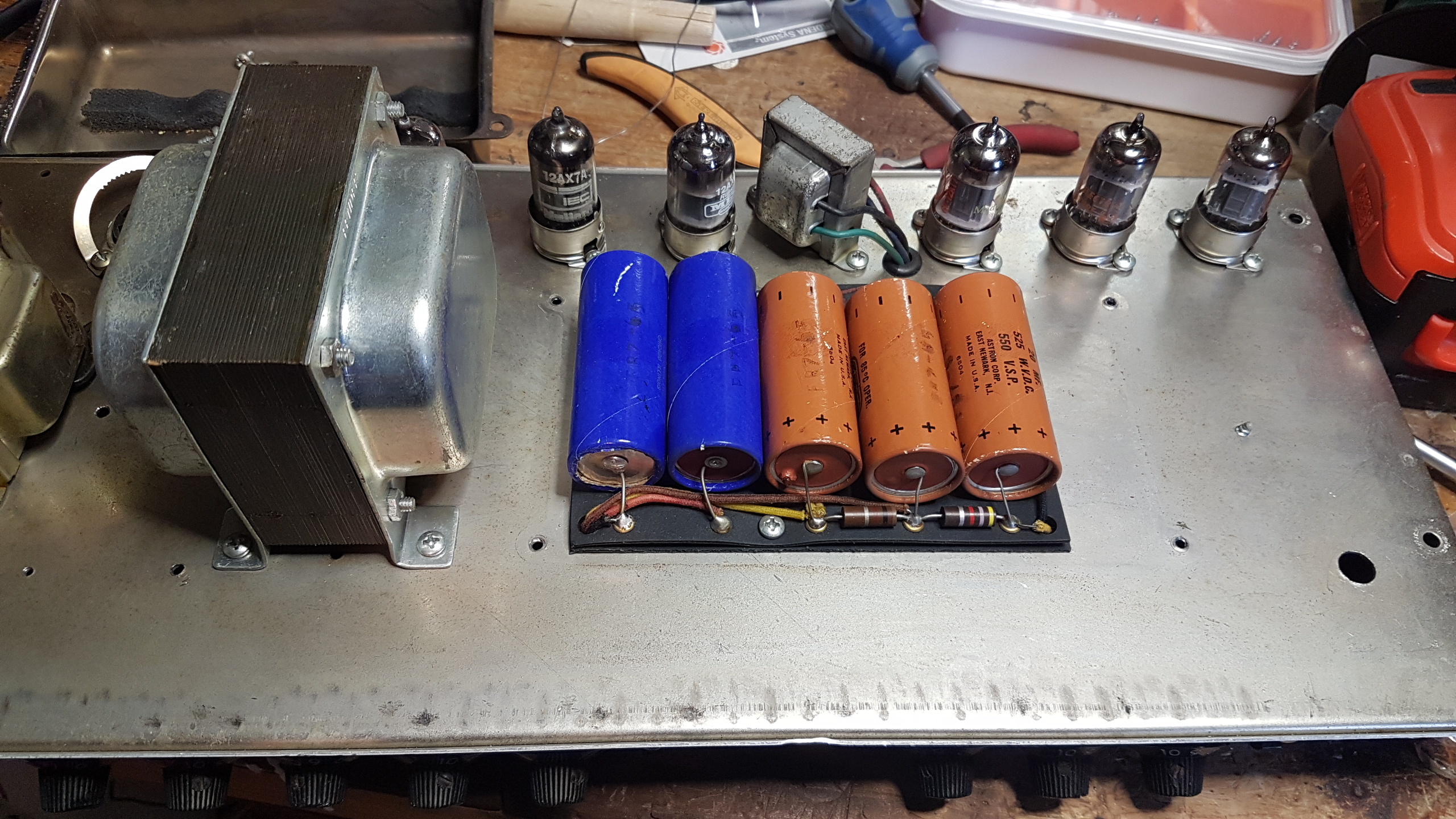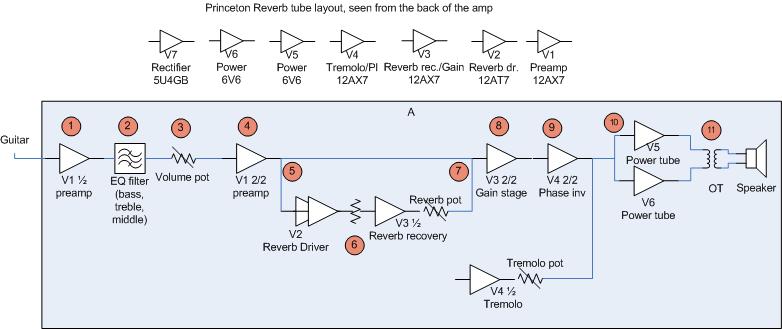Tube vs transistor amps
If you’re struggling with discovering a sweet tone, it’s time you get yourself a proper Fender tube amp. It doesn’t have to be a vintage amp, but is has to be a tube amp. Why? Because they offer a sweetness and warmness that transistor amps cannot compete with. They have this sweet spot where you are just in between clean and distorted lands. You may have heard that transistors are distorting differently and harder than tubes caused by a distinct and sudden signal clipping when max effect level is reached in the transistors. Still, it’s not just the tubes that provide the desired distortion in tube amps. Other components such as big power transformers, DC caps and cathode caps in premp tube stages also contribute to sag and compression. In general, transistor amps don’t have this because they don’t need this to funtion. They are built as light, small, efficient and affordable as possible.
Figure showing large transformers and caps in a Super Reverb
While transitors can operate at typically 40 volts in the power section, Fender 6L6 tube amps require ~500 volts DC. This requires a rectifier (tube or diode), big iron transformers and big capacitors. When striking a chord on your guitar, the whole value chain of electrical components must quickly transport a large amount of energy (current) to all preamp tubes and power tubes. Tube amps usually have a slower response time than transistor amps. When the tubes are pushed hard at high volumes they draw lots of current and the power circuitry cannot deliver this energy fast enough. The amp starts to struggle and reaches its limit of linear operation. This is described as a sweet and forgiving character, a small delay and compression, also known as “sag”. You’ll notice that your amp adds sustain to your notes. A hard string attack will jump sweet, warm and soft out of your speakers, and your note will hold longer.
Sweet Spot
An amp’s “sweet spot” is by most players characterized as the volume level where it starts breaking up and sounds sweet. In the classic Fender blackface amps this is caused mostly by power tube distortion while the preamp section is relatively clean. In most amp circuit designs with no master volume, the power amp section will start to break up before the preamp section. If not, you won’t be able to utilize the full potential of the power amp section. There are several tricks decribed on this web site how to adjust the breakup level for the preamp and power amp section.
On the bigger amps, we like to boost the preamp section so that it breaks up right where, or just slightly after, the power amp breaks up. This results in a fatter tone. On the smaller amps, we usually like to increase the clean headroom of the power amp section.
Signal distortion
In signal theory distortion is defined as a change of amplitude, frequency or phase. How can we relate this to tone, or even a guitar amp? A good tube amp is often described with the terms sag, compression and harmonic frequencies. These are just different words for distortion. Tubes, transformers, capacitors, resistors and speakers contribute in shaping a distorted tone. When you think you’re tone is clean, i.e. a Twin Reverb set at volume=4, there is a lot of distortion coming to play. If you plug your guitar into a 400W Ampeg bass amp, you’ll experience what the term clean means. Distortion is for many tube amp guys considered a good thing since it makes the tone thicker, fuller and with more sustain. This is not desirable for all instruments.
The Princeton Reverb signal chain
Let’s study the circuit design of the Princeton Reverb and walk through the logical stages from where the guitar signal enters the amp to where it reaches the speakers. The other fender blackface/silverface amps works similar with the exception of two channels and different usage of tremolo and phase inverter tubes.
(All the tube stages who are significantly contributing to distortion are written in italic)
- The guitar signal is first amplified through the V1 tube (first half of it). First gain stage. Will distort if signal level is very high (hot humbuckers, boost effect pedals).
- Signal enters the EQ stage with treble and bass pots. No amplification, just filtering some frequencies out / leading current to ground.
- Signal enters the volume potmeter. If volume is set low, much of the signal is lead to ground and lost. Volume pot is not amplifying anything, just letting more current through.
- Signal enters the V1 tube (second half of it) and is amplified. Second gain stage. Will distort if signal level at this point is high, as a result of all previous signal processing to the original input signal. The cathode caps and resitors in preamp tube circtuits will add sag and compression if tube is pushed hard. The cathode cap is also EQ’ing your signal, and you may tweak it to adjust bass levels.
- Signal splits into two paths; reverb path and main path.
- The signal in the reverb path is heavily amplified by the reverb driver tube V2 (both halfs) which drives the reverb tank like a loudspeaker. The reverb tank produces the reverb signal (noise) which is amplified by the reverb recovery tube V3 (first half). The reverb potmeter will regulate the amplified reverb signal. If reverb is set low most of the signal is lead to ground.
- The reverb noise signal and dry signal is merged together.
- Signal is amplified in yet a gain stage by the reverb recovery tube V3 (second half). Third gain stage. Cathode cap and resistor also here contributing to compression/sag and EQ.
- Signal enters the phase inverter tube V4 (second half) and is then affected by the tremolo who increases or decreases signal level (the tremolo uses tube V4 first half). Phase inverter will contribute to distortion.
- Signal enters power tubes V5 and V6 and is amplified and eventually distorted. If level is high enough tube distortion and power supply sag will drastically change the tone.
- Signal enters output transformer and then the speakers. Eventually distorted and sag’ed if signal level is high enough for OT and speakers.


